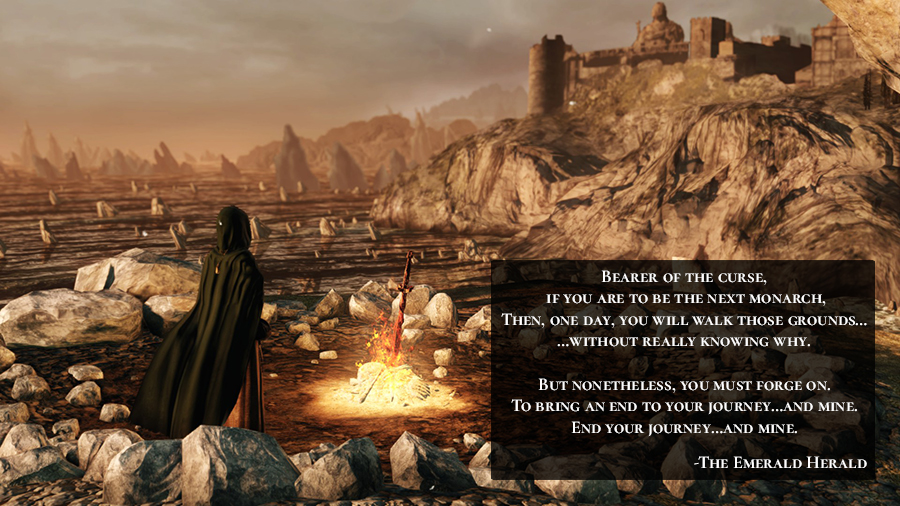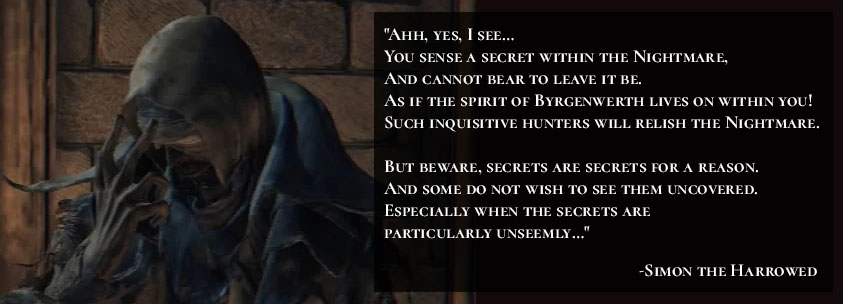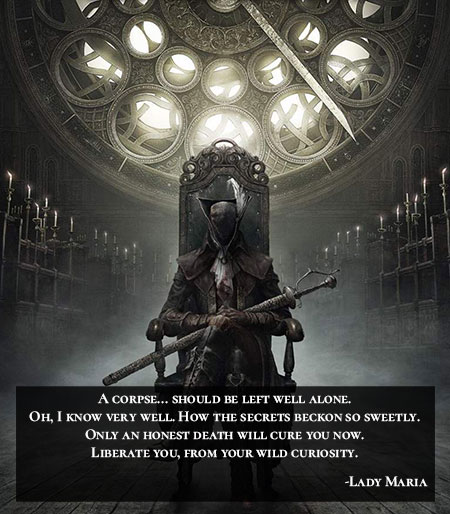Toggle Background Color



A few months ago I was working on a project entirely unrelated to Dark Souls, but my mind likes to forge peculiar connections. Those connections inspired me to look into what happened in the Dark Souls 3 DLC. I didn't have access to it when I first played through the game, and I am very bad at playing games a second time.
Reading about the events in the DLC, I stumbled upon a revelation that completely changed how I see all of these games. I never completed that original project because of how much this new discovery has consumed me. It tells such a beautifully tragic story that lurks just beneath the surface of all these worlds that we thought were familiar, when all we've actually seen is their shadows.



We're going to do lore-focused playthrough of all three Dark Souls games, Bloodborne, and Sekiro, with a heavy emphasis on developer interviews, so that we may have eyes on the inside. This means there will be spoilers both throughout the play through and in the rest of this post.
That said, I'm trying to keep this series accessible to someone with absolutely no knowledge of the series. But if you want a strictly chronological experience you should probably start elsewhere.
"Five let’s plays at once? That's insane!"

In trying to write a Grand Unifying Theory of Soulsborne, I’ve run into a problem: no one, including myself, remembers the details of all five of these games.
These games are actually composed of many different worlds that have had their flames linked. We are rarely ever told explicitly when we transition between timelines, so players tend to interpret them as one unified world that they seek to explain through a single, linear narrative. This process of mistranslation is likely intentional, mirroring Miyazaki's early experiences with English-language novels involved him filling in the blanks of the sections he couldn't understand.
Miyazaki's passion for reading is life-long, extending from his time poring over library books at a young age. Even though he couldn't read all the English stories of dark fantasy and horror, he created his own personal narratives to stitch together the excerpts he could understand.
But another way to see these games is a single tragic narrative happening over and over again. They share the same core DNA, but each one also has its own unique mutations. We only see fragments of each story, but sometimes we can spot blood echoes, motifs present in two separate timelines. If we transpose our knowledge of the context of one motif into the other, sometimes that produces a resonance, signalling that we've stumbled upon a more complete understanding of the underlying narrative.
I like to think that this way of creating – leaving spaces – is satisfying. So if there are incomplete aspects of Dark Souls III, please forgive us. When the player is inside the world of the game, there are various places where they feel they may be able to peek behind the curtain, pry open a window and see beyond.
In this light, you can see the Souls series as a sort of forensic puzzle. Once you start putting all the pieces together you start seeing the games in a completely different light. Maybe even a more complete understanding both of what they are, and also what they were supposed to be.
Dark Souls is in some ways an incomplete game, and I like to think that it has been completed by players, by their discoveries, as they moved along. I’d love to say that the nature of this incompleteness was completely deliberate, but it is both deliberate and by accident, in different ways.
My hope is that recording a playthrough of all these games concurrently will create a visual record of these echoes for my reference purposes. It might also challenge me in several ways. I've already found that playing through even the most mundane challenges of these games while also formulating a detailed description is rather difficult. It will also force me to play through the games and sections I tend to avoid or burn out on. And finally, exposing my thoughts to the world might lead to people pointing out things I've gotten wrong or connections that I have missed.


But some of you might need a more concrete pitch, so here's the more detailed description of where things are headed.

The embering of this theory begins with the intro to the Painted World of Ariandel DLC of Dark Souls 3. Slave Knight Gael explains to us that the Forlorn are those "who have no place to call their own." If this applies to the denizens of the Painted World in Dark Souls 3, why not try applying it to the denizens of the Painted World in Dark Souls 1, particularly Priscilla.
In the Design Works interview for Dark Souls 1, they call Priscilla someone who has "been chased away from her natural place," which echoes Gael's description of the Forlorn. Miyazaki then elaborates that "'natural place' means something slightly different in this case." This interview is curious in how quickly Miyazaki changes the topic away from Priscilla multiple times, as if there's something emotionally painful in talking about her that he wants to avoid. They also mention that his vision for her was so specific that they contracted an outside art studio to produce it. This is curious because it suggests they went to extra expenses to make a highly detailed art asset that they then lock off in an easily missed side area. It does not make sense.
Elsewhere in the interview they talk about Dark Souls 1's Firelink Shrine. They reveal that it was the original location of Priscilla, and that she was originally the heroine of the story. In this abandoned narrative, Firelink Shrine was designed as a water temple, but that "as work on the game progressed, and the image of kindling and fire became more prominent, the water gradually dried up."
And that's when it hit me: the maps in these games are always missing water.
So my theory is that Dark Souls (or Demon's Souls, the flow of time in game development is convoluted) was originally going to be a water-focused game centered around Priscilla. This had to be abandoned when they couldn't produce decent looking water physics on the Playstation 3 without absolutely killing frame rates. Because of this hindrance, large amounts of dev work would have had to been scrapped, but Miyazaki came up with the pyromancy of merging it all into a singular waste land abandoned by its creator with an endless cycle of monarchs invading other worlds in a desperate attempt to stave off the extinction.
But this ritual required the execution of the original denizens of these worlds. Hunting them down like beasts. Massacring the inhabitants of a hamlet and carving out their skulls in search of insight. But Miyazaki, or Havel, or Gehrman couldn't bear to kill one character, and so he hid her away to keep her safe.
Except that surviving orphan eventually discovered what happened to her kin.











